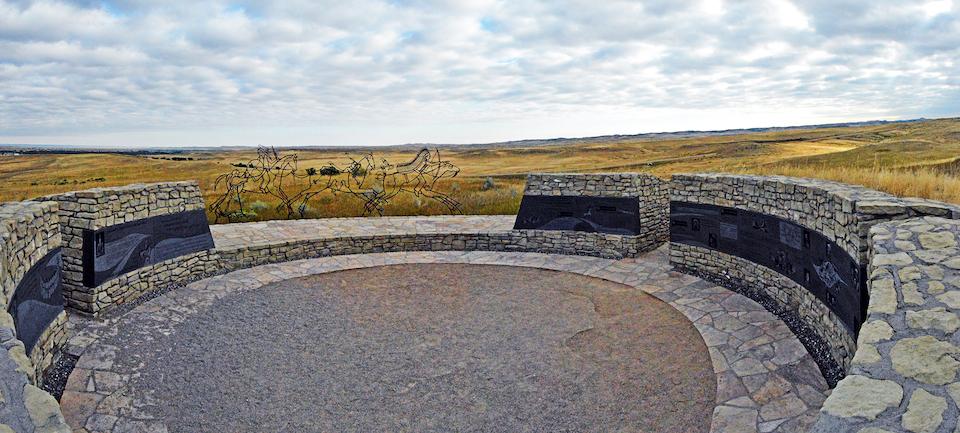
A new visitor center is coming to Little Bighorn Battlefield National Monument/NPS
After years of need, Little Bighorn Battlefield National Monument in Montana is getting a bigger and better visitor center, one with the space and proper environmental controls to display more of the monument's archaeological collections.
The project, funded with help from the National Park Foundation, the Leona M. and Harry B. Helmsley Charitable Trust, the National Park Service, and Friends of the Little Bighorn Battlefield, follows years of controversy tied to a proposed expansion of the current visitor. A lawsuit in 2008 stopped that plan.
The 2008 plan called for an enclosed theater seating 200 people at the base of Last Stand Hill, site of the climax of the 1876 battle in which Lt. Col. George Armstrong Custer and five companies of the 7th Cavalry were wiped out. While concerns over the project had prompted then-National Park Service Director Mary Bomar to give the project further review, Public Employees for Environmental Responsibility went to court to stop the project, claiming it would occupy the middle of the battlefield and block views of how the battle evolved as well as where it ended.
Problems with space shortages and poor curatorial facilities in 2011 led to the monument's museum collections to be moved far south to the Park Service's Western Archaeological and Conservation Center in Tucson, Arizona. Those collections included roughly 150,000 artifacts and archives tied in some fashion to the 7th Cavalry's darkest days in June 1876. Among the artifacts were Custer's buckskins.
The new visitor center announced Thursday is viewed as a significant step forward as the National Park Service works to make tribal artifacts and their interpretation more accessible to tribes and the public, and expand stories and perspectives about the multifaceted history and legacy of the Battle of the Little Bighorn.
"The building itself will better protect museum collections through improved environmental controls, while its contemporary design will blend with the surrounding landscape, including large windows and a roof terrace with a view of the battlefield," a park release said. "With greater access to exhibits, enhanced functionality, and new areas for interpretive and educational programs, the facility will enable visitors to engage with a powerful place-based experience during their visit."
A key benefactor of the new visitor center is the Helmsley Charitable Trust, which is providing $4.5 million towards the facility.
“This is a significant site in American history with an amazing story to tell," said Walter Panzirer, a Helmsley trustee. "The new visitor center will preserve, protect, memorialize, and interpret the cultural and natural resources of the park, including the landscape and the park’s world-class artifact and document collection for future generations.”
The press release did not mention the location of the new facility, and Park Service staff at the national monument and in the Intermountain Region office in Denver could not be reached Thursday to provide that information. The monument's existing visitor center currently is closed due to Covid-19 precautions, and no ranger tours are being offered at this time.
With the 150th anniversary of the battle approaching on June 25 -26, 2026, the new visitor center will enable the National Park Service and partners to provide visitors with an experience that takes in the historic significance of the Battle of the Little Bighorn.
“The National Park Foundation is grateful to the Helmsley Charitable Trust for their transformative investment in the visitor experience at Little Bighorn Battlefield National Monument,” said National Park Foundation President and CEO Will Shafroth. “Thanks to the collaboration of numerous stakeholders, visitors will engage on an even deeper level with one of the most decisive battles in American history. We look forward to continuing to work with national, state, local, and tribal partners on this important project.”
Little Bighorn Battlefield National Monument commemorates the 1876 Battle of the Little Bighorn and its resulting effects on westward expansion. At the battle, Lakota and Cheyenne warriors defeated Custer and the U.S. 7th Cavalry.
“The new facility will improve interpretive and educational programming and honor the longstanding relationship among the National Park Service and tribes historically associated with the site,” said Little Bighorn Battlefield National Monument Superintendent Wayne Challoner. “Tribal input was a critical component in the overall planning process, which began nearly a decade ago, and will continue to play a significant role as we construct the visitor center, focus next on completing the curation facility and all the artifacts are returned.”
The planning process for the new visitor center is well underway and it is projected that it will open to the public in June 2024. Planning to complete an adjacent curation facility continues as the National Park Service works to secure funding to complete construction. The new visitor center will help to ensure that Little Bighorn Battlefield National Monument continues to offer education and inspiration for current and future generations while generating economic benefits to local communities and the State of Montana.



Add comment